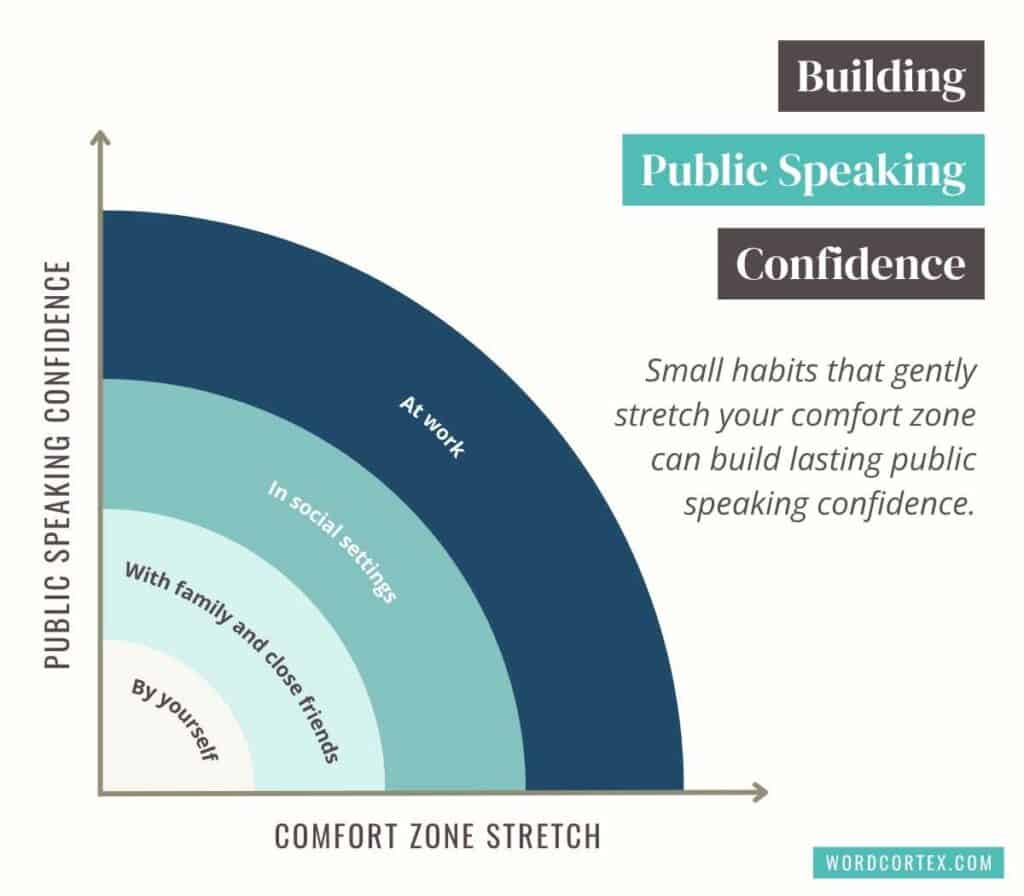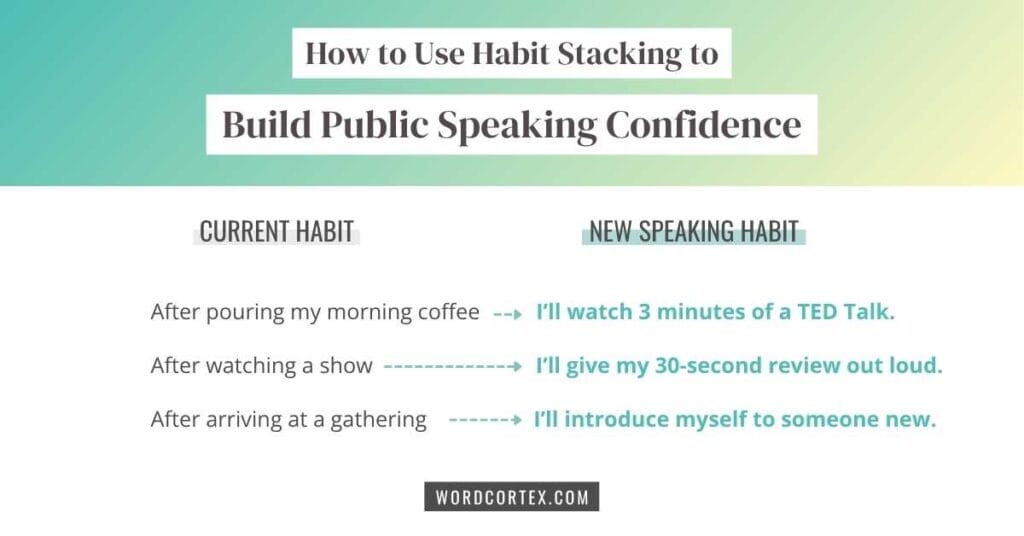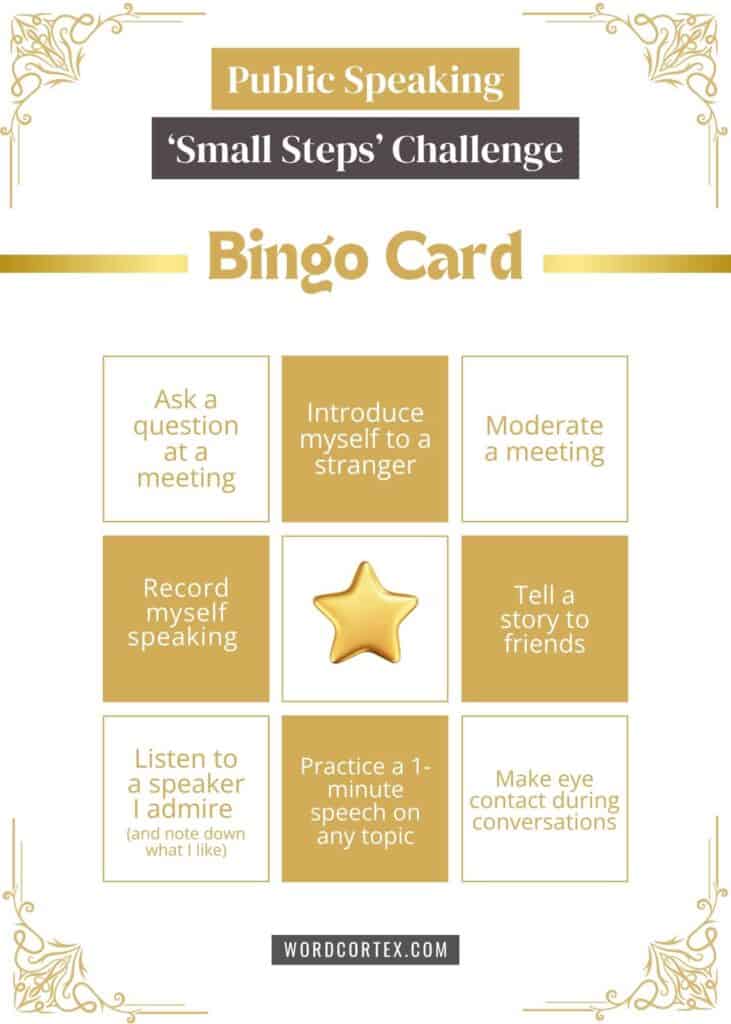Small Everyday Habits to Build Confidence in Public Speaking
Many of us white-knuckle our way through speeches, wondering why the nerves never go away.
Is there a secret that charismatic public speakers have kept from us? Where do they get their confidence?
You know the type — that one colleague who articulates their point effortlessly in meetings, tells captivating stories, and always seems to know the right thing to say… much to our envy.
It’s easy to assume that good public speakers are “naturally gifted”.

But here’s the truth: public speaking isn’t a personality trait — it’s a skill.
Like any skill, it gets stronger with practice.
In this article, I share 39 everyday habits that slowly but surely build public speaking confidence without stress or pressure.
Low-Pressure Ways to Steadily Build Public Speaking Confidence
Good public speakers aren’t made overnight. And confidence doesn’t come from one brave act.
Real growth happens in the small, low-pressure moments that stretch our potential just a little each time.
We’re going to take a closer look at those “learning moments” — and how to create them.
The best way to grow your public speaking confidence is to integrate speaking habits into your everyday life — when you’re with friends, at work, or even on your own.
These daily moments, while seemingly small, can create powerful shifts over time.

I’ve categorized them into 4 levels:
- In your own time
- With close friends and family
- In social settings
- At work
Each layer represents a safe, accessible environment to try something new and gently stretch your boundaries.
As you move from solo practice to social interactions and eventually to professional settings, your speaking confidence builds naturally.
Let’s explore these simple, everyday speaking habits that you can start building right away!
In your own time
1. Watch a TED talk and analyze it
Pick a TED Talk on a topic that excites you. Watch the video twice: the first time, you’re just listening to the speech as an audience member; the second time, you’ll analyze it.
Pay attention to 4 aspects of the speech:
- Content (key takeaway, stories used)
- Structure (speech start and end, story structure)
- Visuals (slide design)
- Delivery style (vocal variety, pauses, body language, speech speed, etc.)
Make notes about what impressed you. Equally, if you disagreed with the speaker’s communication choice, write down what you would have done better.
💬 Skills in use: Observational learning, awareness of speech structure and delivery techniques
2. Read something out loud for 3 minutes
Whether it’s a news article, your favorite book, or even a to-do list, reading aloud improves clarity and vocal control.
If you’re feeling motivated, choose a novel, a movie script, or a children’s book to read aloud. These offer ample opportunities to practice vocal variety and projection.
💬 Skills in use: Articulation, pacing, and vocal variety
3. Listen to podcasts with strong speakers
Absorb the cadence, tone, and conversational flow of good communicators during interviews or storytelling shows.
💬 Skills in use: Listening skills, observational learning, awareness of delivery techniques
4. “Shadow speak” a motivational speech
Play a speech you like and try to repeat the speaker’s words in real time, matching their delivery style. It’s like singing along to your favorite song, except it’s a speech.
The goal here isn’t to copy someone else. It’s to practice vocal variety and speech delivery.
💬 Skills in use: Vocal variety and projection, speech delivery techniques
5. Read articles or books on effective communication
You’re already doing this right now! Consuming content on topics such as public speaking, storytelling, body language, or persuasion educates you on the best practices.
Over time, you can start implementing these one by one in your speeches or use them to analyze other speeches.
💬 Skills in use: Theoretical understanding, awareness of several communication tactics
6. Practice confident body language in front of a mirror
This is a no-judgement zone. Try striking the power pose stance. Try standing with your shoulders square and chest out. How do you look? And more importantly, how do you feel?
Soon you’ll learn how to project confidence using only your body language.
💬 Skills in use: Non-verbal communication, presence
7. Try “1-minute talks” on fun topics
Start the timer and speak for an entire minute on any topic of your choice. It doesn’t have to be perfect.
What topics to choose? Well, it can be as simple as “my favorite X” – book, movie, cuisine, song, and so on. Or, your take on the latest headlines.
💬 Skills in use: Impromptu speaking, idea organization
8. Record yourself speaking and review it
I know, I know. Listening to our own voice is the worst! But I wouldn’t be recommending it if it weren’t helpful. I swear, recording myself has been one of the most effective ways I have improved my speaking skills.
So, press that record button on your phone or on Zoom as you deliver your 1-minute speech. Then, play it back to review it.
Use the same 4 steps of speech analysis to offer feedback to yourself: (1) content, (2) structure, (3) visuals [if applicable], (4) delivery style.
💬 Skills in use: Awareness of speech structure and delivery techniques, deliberate practice
9. Narrate your actions out loud
It may seem silly, but talking through what you’re doing while cooking, getting ready, or tidying up builds your impromptu speaking skills.
At first, you may not immediately find the right word for the thing you’re doing. But over time, you’ll be surprised at how much your storytelling and verbal fluency improve.
💬 Skills in use: Storytelling, verbal fluency, explaining clearly
10. Watch a celebrity interview, and try answering the questions
Find a talk show or a red carpet interview. Pause after each question the host asks, and give your own answer as if you’re the celebrity!
💬 Skills in use: Impromptu speaking, storytelling
11. Give an imaginary acceptance speech
Pretend you’ve won an award and give a 1–2 minute thank-you speech out loud — bonus points for holding a shampoo bottle as the imaginary award.
💬 Skills in use: Impromptu speaking, idea organization
12. Practice introducing yourself
Can you describe what you do clearly? Practice different variations of your introduction until you find one that’s just right.
💬 Skills in use: Clarity and brevity in communication
Resource: If you’re introducing yourself in a presentation, I have 5 ready-to-use self-introduction scripts that you can adapt and use.
13. Visualize yourself nailing a speech!
Close your eyes and imagine standing in front of the audience, delivering your speech. Your words flow smoothly. Your stance is confident. You see people nodding and smiling at you. When you’re done, you hear applause.
💬 Skills in use: Mental preparedness
Resource: I found this helpful article that highlights the science behind positive visualization and how to practice it.
With family, close friends, or roommates
14. Talk about your day
When your roommate or partner asks, “How was your day?” that’s your cue to deliver a 1-2 minute speech. Instead of the boring, “It was good,” get specific and descriptive about your day.
💬 Skills in use: Storytelling, impromptu speaking
15. Share something new you learned today
Listened to a fun podcast? Read an interesting article? Share it with your loved one. Remember to add 3 reasons why you enjoyed it — and voilà, there’s your mini speech.
💬 Skills in use: Idea organization and articulation
16. Critique a movie or show after watching it
Go on — rant about that bad movie! But instead of just saying, “It was so bad!” get deeper and describe exactly what you disliked, and what could have been better.
💬 Skills in use: Idea organization, providing feedback
17. Pitch a weekend plan and justify it
Ditch the “So what do you wanna do this weekend?” and replace it with a fully fleshed-out plan. Start with, “Here’s what I think we should do…” and then lay out your ideas along with reasons why it will be fun.
💬 Skills in use: Idea organization, pitching an idea
18. Practice active listening and ask follow-up questions
When your roommate, friend, or partner talks about their day or shares something with you, pay attention. Then ask a thoughtful follow-up question to keep the conversation going.
💬 Skills in use: Active listening, interpersonal communication
19. Give a compliment
Show your friend or family member your appreciation for something they did. Be specific and sincere in your praise.
💬 Skills in use: Interpersonal communication, vocal variety
20. Debate a silly topic playfully
Cats versus dogs. Pineapple on pizza or nah? Tea versus coffee. Pick a fun topic to debate and make your case!
💬 Skills in use: Persuasion, idea organization
In social settings
21. Introduce yourself to someone new
You’ve practiced introducing yourself at home, now it’s time to use that script in real life! When you attend an event, say hi to at least one stranger and start a conversation with them.
💬 Skills in use: Interpersonal communication
22. Thank the host at a friend’s dinner
A simple 2-line ‘thank you’ speech can go a long way. Start by thanking them, and then mention something specific that you enjoyed about the evening.
💬 Skills in use: Brevity in communication
23. Host a game night or casual hangout with friends
Ready to flex those leadership muscles in a low-risk environment? Invite a few friends over for a game or movie night. Take the lead in initiating conversations: “What do you think about X?”
💬 Skills in use: Leadership, interpersonal communication
24. Explain the rules of a board game to friends
Your friends will forever thank you for simplifying those painfully complex rules. Plus, you get to practice public speaking without any risk!
💬 Skills in use: Structuring information, explaining concepts clearly
25. Talk about a book, movie, or show you enjoyed
Go ahead — tell us why you enjoyed Squid Games. Get specific with your answer: “I enjoyed it for 3 reasons, first….” And, if your friend ends up checking out the show because of your recommendation, congrats, your persuasion has worked!
💬 Skills in use: Idea organization, persuasion
26. Share a personal story
Did your car break down? Did you forget an appointment? No matter how big or small, try sharing a personal story with friends. Start with, “Do you know what happened the other day…” and then describe your experience.
💬 Skills in use: Storytelling, vocal variety
27. Start a conversation about an interesting topic
Show that you can lead a conversation by asking a question and then inviting input from others. Just keep the topics more general and the questions open-ended so that everyone can join in.
💬 Skills in use: Leadership and facilitation
28. Participate in group discussions
Contribute to the discussion with an interesting fact you read. Or share why you agree (or disagree) with someone else’s point. Your goal is to be seen and heard within the group.
💬 Skills in use: Interpersonal communication, active listening
29. Introduce a guest speaker at a meet-up group
Local meet-ups tend to invite guest speakers. Volunteer to introduce the guest speaker. Deliver a 2-3 line short speech welcoming the speaker to the stage.
💬 Skills in use: Public speaking, brevity in communication
Resource: Learn everything about introducing a guest speaker, from prep to delivery — plus 4 sample scripts you can copy or adapt.
30. Attend a local public speaking group
Toastmasters is a popular public speaking group with clubs in nearly every country. Expect a friendly, safe environment to learn and grow. That’s where I started practicing public speaking. Feel free to attend as a guest first and then gradually try other speaking roles in the meeting.
💬 Skills in use: Public speaking, deliberate practice, active listening
At work
31. Use confident body language in meetings
Square your shoulders. Spine straight. Sit tall. Make eye contact. 💪
💬 Skill in use: Non-verbal presence, leadership cues
32. Ask a question after a presentation
One of the easiest ways to “be seen” at work is to ask a thoughtful question at a presentation. You’ll get practice speaking in front of others — without any risk. It’s a win-win!
💬 Skill in use: Speaking up in formal settings, comfortable being seen and visible
33. Compliment a coworker publicly
Make someone’s day by complimenting them for their contribution or skill.
Show appreciation for a colleague’s work on a project, their positive traits, or a particular skill they demonstrated, for example, handling a client meeting well. But stay away from complimenting their looks or physical attributes.
💬 Skills in use: Interpersonal communication, vocal variety
Resource: I found this helpful article on ways to compliment someone beyond their looks.
34. Share your opinion in a meeting
“That’s a good idea!” or “Actually, I have a suggestion for a slightly different approach.” Whichever route you take, remember to clarify why you feel that way.
💬 Skills in use: Assertive communication, idea articulation
35. Volunteer to moderate a meeting
Take charge of the next meeting by facilitating it. You get to welcome the team, share the meeting’s agenda, introduce speakers, and keep the meeting flowing smoothly. That may seem daunting, but remember, you only need to say a sentence or two between speakers.
💬 Skills in use: Facilitation, public speaking, leadership, impromptu speaking
36. Observe how a senior leader communicates
Pay attention to their tone, structure, body language, and audience engagement tactics. How do they handle tough questions or tricky situations?
💬 Skills in use: Speech analysis, passive learning
37. Make a short announcement
It could be about a rescheduled meeting or an upcoming deadline. Making a quick announcement is a low-risk way to practice speaking in front of others. You don’t need to prepare anything in advance –- just relay the message out loud.
💬 Skills in use: Brevity and clarity in communication, vocal projection
38. Volunteer to train a new coworker
Walk them through a process or tool in your own words.
💬 Skills in use: Structuring information, explaining clearly
39. Give a project update
A short project update includes 3 talking points: (1) the recent wins of the project, (2) what’s in progress, and (3) the next set of proposed actions. Try including an accompanying slide with relevant graphs or an infographic, if applicable.
💬 Skills in use: Summarizing information, public speaking
How to Start and Keep Up New Habits for Improving Public Speaking
You’re probably thinking: These daily habits sound great. But I doubt I can stick with even one new habit, let alone several.
Let me share a little secret to creating and keeping new habits — habit stacking.
I learned about habit stacking from James Clear’s bestselling book Atomic Habits, where he explains that the best way to create a new habit is to attach it to something you’re already doing regularly.
You can use this simple format to start:
After [current habit], I will [new speaking habit].
This method works best when the “current habit” is something you do without fail — making coffee every morning or joining a team meeting every Monday.
Here’s how to use habit stacking to build public speaking skills.
- After pouring my morning coffee → I’ll watch 3 minutes of a TED Talk.
- After watching a show → I’ll give my 30-second review out loud.
- After arriving at a gathering → I’ll introduce myself to someone new.
- After a coworker presents → I’ll offer a specific compliment.

Using habit stacking to gradually add a new habit makes public speaking a regular, casual activity and takes the pressure out of it.
Over time, as you flex these tiny habits in everyday settings, effective communication becomes an integral part of your life.
Track Your Public Speaking Wins In Fun Ways!
Turn progress into something visible — and fun — to get a steady dose of motivation and a growing sense of pride in how far you’ve come.
Below are two ways to do just that:
Create a ‘Public Speaking Challenge’ Bingo Card!
If you love the feeling of checking something off a list, you’re going to love this.
A public speaking bingo card turns small speaking wins into a light-hearted challenge. Each square contains an easy, everyday speaking task — like “introduce myself to someone new,” or “ask a question in a meeting.”
As you complete each task, cross it off. Aim for a row, column, or full blackout.
And bingo! You’re gradually building skills like articulation, speech analysis, and vocal variety without the pressure of giving a formal speech.
🌟 Use this ‘Public Speaking Wins’ bingo card I’ve designed to get started right away! It’s packed with simple, small wins that will nudge you out of your comfort zone, one box at a time.

Reward or treat yourself
Don’t wait for someone else to hand you a gold star — give yourself one! Pair your progress with small treats that make you smile.
When you hit specific milestones, treat yourself to a nice meal or a new book.
For example:
- Shared your opinion in a team meeting? You get to try the new cinnamon-spiced latte.
- Moderated your first meeting? Watch an episode (or two) of The Bachelor guilt-free.
This triggers your brain’s reward system (hello, dopamine!) and makes you want to keep up the momentum.
Keep the rewards enjoyable and aligned with your effort, not the outcome.
Make Public Speaking an Essential Life Skill – One Tiny Habit at a Time
Confidence in public speaking isn’t built from one big moment. It is quietly shaped through tiny, consistent habits that you practice every day.
From the list above, choose 5 tiny habits that you’ll try. Whether it’s reading out loud, moderating a meeting at work, or sharing a story with friends, these small wins add up over time.
Eventually, the cumulative effects of these micro-moments make public speaking seem more natural.
So, keep showing up, one tiny habit at a time, and confidence will follow.
Get actionable communication tips straight to your inbox
No fluff. Just valuable insights and practical strategies to communicate better.
We promise to keep your email address safe.
By signing up, you agree to receiving communication tips and sporadic updates from Word Cortex. You can unsubscribe anytime.






